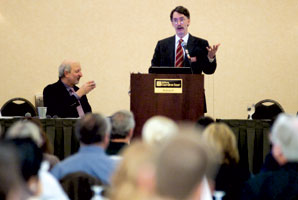For the last several years, University of Montana analysts Paul Polzin and Patrick Barkey have been stopping through Kalispell as part of what might best be described as a traveling road show of depressing economic news. Their presentations typically elicit sighs and gasps from local business leaders as their findings confirm what many already know: that a particularly brutal recession has been exceptionally cruel to the economy of Northwest Montana in almost every way.
On Friday at Kalispell’s Hilton Garden Inn, however, their message contained hints of optimism, along with liberal helpings of candor regarding the substantial obstacles in the way of full recovery for the economies of Montana and the nation.
“Believe it or not, the short-term outlook is brightening,” Barkey, director of UM’S Bureau of Business and Economic Research, said. “We believe 2011 will be the year when we see meaningful growth in the Montana economy.”
 |
|
Patrick Barkey, director of the Bureau of Business and Economic Research at the University of Montana, delivers the first half of his speech, titled “Paying for the Recession,” during the 2011 Economic Outlook Seminar at the Hilton Garden Inn in Kalispell. |
A host of factors will have a hand in improving the economy in 2011, according to Barkey. Faster growth abroad should boost U.S. exports. The temporary cut in payroll taxes has been extended as a result of President Barack Obama’s deal with Republicans. Inflation thus far is not a problem, nor was the prospect of a double-dip recession raised.
And Barkey predicted 3 percent growth in the economy should finally begin to chip away at unemployment.
“Jobs are one of the last things to swing into growth as the economy recovers,” Barkey said, before forecasting growth in non-farm labor income at 2.6 percent in 2011, following 0.9 percent growth last year. In 2012, growth will continue at a rate of 2.9 percent.
Of the state’s basic industries, Barkey anticipates a strong year for mining, agriculture and manufacturing. Wood and paper products should remain “depressed”: not declining, but not improving. Tourism and transportation will recover along with the national economy. It’s unclear whether federal military employment will grow, and federal civilian employment could see mild declines.
At the local level, Polzin outlined just how hard Northwest Montana was hit by the recession when he showed how Flathead County’s annual rate of growth averaged 4.7 percent between 2001-2007, and decreased 6 percent during 2008 and 2009. On top of that, the Flathead suffered significant declines in real estate and construction, and saw the permanent reduction of major industries like timber and manufacturing.
“That’s the one-two punch that made Flathead County probably the epicenter of the recession,” Polzin said.
But recent statistics indicate Flathead job growth may have begun to rebound in the third quarter of last year, though it’s occurring in a smaller economy.
“It’s going to take several years of growth to get back to where the Flathead economy was when this recession began,” Polzin said. His forecasts for Flathead County’s basic industries mirrored the state’s, with slow growth in tourism, transportation and manufacturing, while wood products, primary metals and the federal government hold steady. Polzin predicted 2.5 percent growth for the next two years in Flathead County.
“Over the next several years you’re going to be growing, but at a slower rate,” he added.
Barkey prefaced the mildly optimistic forecasts, however, by noting the deeper structural problems in the U.S. economy revealed by the recession. While consumers’ savings rates have improved as they shed debt, and housing prices have corrected to correspond more closely with traditional growth trends, America’s trade imbalances with other nations, and the federal deficit are worsening.
 |
|
A row of attendees lines the back row of a room at the Hilton Garden Inn during the 2011 Economic Outlook Seminar in Kalispell. |
State governments, meanwhile, face budget deficits that could worsen as federal stimulus ends, tax revenue decreases due to declines in property values, and increased obligations to Medicaid and public pension commitments.
“Debt is growing as a proportion of our economy; that’s an unsustainable situation,” Barkey said. “This is the opportunity, if you will, to make the change.”
Several other experts gave brief remarks on other economic sectors, from health care to agriculture to real estate. Todd Morgan, who analyzes the wood products industry, predicted another year of modest improvements, similar to 2010 but much better than 2009.
In 2010, according to Morgan, the wood products industry endured its fifth year of declines as it weathered the impacts of 2009. The closure of the Smurfit-Stone plant in Missoula resulted in declines in employment and product sales value, but lumber production increased 15 percent and timber harvest volume increased 12 percent. In a survey of Montana’s remaining wood products executives, 46 percent expect 2011 to be better than last year, while 35 percent expect to fare roughly the same.